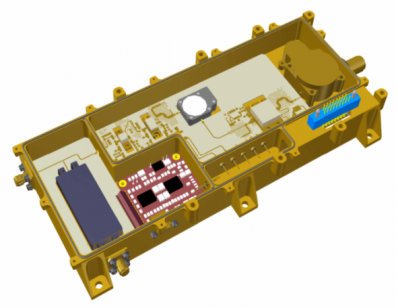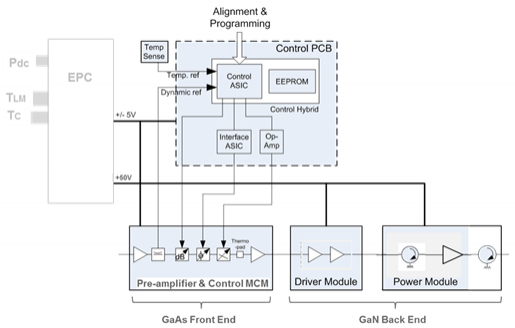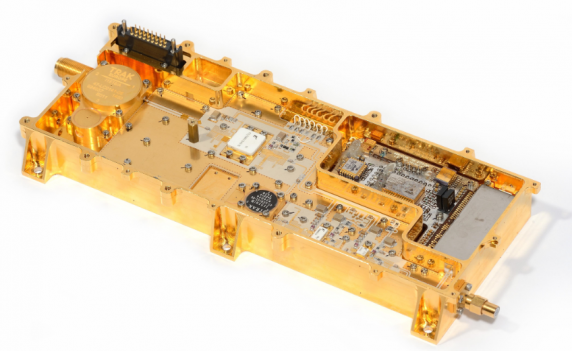-
StatusCompleted
-
Status date2016-12-19
-
Activity Code5C.238
Although the proposed development is aimed at a specific payload application, it is important to appreciate that it is also a vehicle to develop a generic platform for future lower cost SSPA designs. An ‘Integrated Back End’ (IBE) approach will be applicable up to and including C Band, and will improve Airbus Defence and Space’s competitive position at equipment level in a range of markets.

L-Band GaN SSPA Concept Drawing
The supplier of the MCM package routinely undertake a stress analysis. Due to the lid seam-sealing method, the initial proposed design failed the thermo-elastic stress simulation due to the larger DC feedthrough substrates for this MCM model. The design was therefore altered over three iterations and the final design has recently been approved by both parties and following this the Package was ordered.
Although not hermetically sealed, the EBB MCM has exactly the same internal box dimensions and test interface as the EM MCM. As the EBB MCM is electrically representative the electrical test of the EBB MCM mitigates electrical risk and expedites the test solution for the EM MCM.
The major benefits are summarised below:
- Introduce high efficiency GaN FETs into SSPAs
- Reduce costs through design for Manufacture and Test
- Develop Integrated Back End Concept into manufacturable product
- Replace obsolete components
- De-risk design activity ahead of on-programme qualification work
The L-Band SSPA provides amplification with high linearity. Phase and gain tracking performance between equipments within the payload is critical. In order to minimise overall power consumption the equipment operates over a range of defined back-off levels over the specified temperature range. The equipment uses a GaN driver and back end, implemented on a single circuit board.
The equipment comprises an amplifier module, electronic power conditioner (EPC) and interconnecting cable as shown in the functional block diagram below.
The work packages do not include an EPC, which provides power from the spacecraft primary bus; and telecommand and telemetry interfaces.
The equipment is required to provide a measurement of the current demand. Each SSPA contains overdrive current limiting and automatic undervoltage disconnection from the spacecraft primary bus.

The project is split into three phases. Phase 1 includes the Baseline Design review and runs from March to June 2014. Phase 2 includes detailed SSPA design and will run from June to October 2014. Phase 3 includes the test results review and final report and will run from October 2014 to the project conclusion in November 2016.
Airbus Defence and Space Limited, Portsmouth UK, has successfully completed an ARTES 5.2 funded development of a new, more efficient and high reliability approach to Solid State Power Amplifier (SSPA) manufacture using Gallium Nitride based RF power technology. Building on an extensive heritage in L-band and C-band SSPAs for Telecommunications and Navigation missions Airbus Defence and Space has taken advantage of commercial techniques to produce an integrated amplifier, dispensing with many costly elements used in previous designs.
An EM quality SSPA has been designed using a multi-layer soft board approach instead of traditional ceramic tiles and carriers. Excellent performance and reliability have been established by undertaking a limited life-testing and a partial qualification test campaign which gives very high confidence the design can easily be transitioned to a fully flight qualified state. In addition, the accurate phase and gain tracking characteristics demonstrated in our heritage designs has been maintained such that we can confidently use this design approach for next generation L-band mobile missions.
As part of a comprehensive re-design of the SSPA the small signal gain and RF control section was modernised with a new HTCC module and the design has been validated by building 20 modules which were subjected to in depth evaluation and test. An existing control PCB design was also modified to accommodate the requirements of new MMICs used in the updated module.
The overall SSPA test approach has also been improved with a significant increase in throughput during production realised through streamlining of test stages and the optimisation of test algorithms. The new tests were used to successfully characterise and evaluate the SSPA RF tray performance which demonstrated over 30W of output power and >50% power added efficiency and an associated NPR linearity in excess of 17dBc.
This successful development has resulted in a significantly more robust and manufacturable product.




